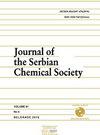新冠肺炎疫情期间,小学一年级学生在线学习Brønsted-Lowry酸碱理论的效果
IF 1
4区 化学
Q4 CHEMISTRY, MULTIDISCIPLINARY
引用次数: 0
摘要
本文的目的是研究在线材料的应用对Br?nsted-Lowry理论是基于一年级文法学校学生在COVID-19大流行期间积极构建知识。在线教材的设计目的是使学生能够:(a)以较小的部分学习教材;(b)在学习完教材的每一部分后,评估所学的知识;(c)按照自己的进度学习;(d)通过录像和插图将酸和碱内容的宏观、亚微观和符号表示可视化并相互关联;(e)重新检讨所提供答案的准确性。研究样本包括122名一年级文法学校的学生,他们学习了Br?第一次提出了嵌套-劳瑞理论。本研究使用的工具是两个测试(前测和后测),其效度由两位大学教授和两位文法学校的化学老师进行检验。应用方法使大多数学生能够积极地构建知识,同时使教师能够洞察过程的进展和结果。本文章由计算机程序翻译,如有差异,请以英文原文为准。
The effects of online learning about the Brønsted-Lowry theory of acids and bases in the first grade of grammar school during the COVID-19 pandemic
The aim of this paper was to examine the effects of the application of online material on the Br?nsted-Lowry theory of acids and bases on the active construction of knowledge in first-grade grammar school students during the COVID-19 pandemic. The online material was designed to enable students: (a) to learn the teaching material in smaller parts; (b) to assess the acquired knowledge after each part of the teaching material; (c) to progress through the lesson at their own pace; (d) to visualise and interrelate the macroscopic, submicroscopic and symbolic representations of the contents about acids and bases by using a video recording and illustrations; (e) to re-examine the accuracy of the given answers. The research sample consisted of 122 first-grade grammar school students, who learnt about the Br?nsted-Lowry theory for the first time. The instruments used in this research study were two tests (a pre-test and a post-test), the validity of which was examined by two university professors and two grammar school chemistry teachers. The applied approach enabled the active construction of knowledge in the majority of students, while it provided the teachers with an insight into the progress and outcomes of the process.
求助全文
通过发布文献求助,成功后即可免费获取论文全文。
去求助
来源期刊
CiteScore
1.80
自引率
0.00%
发文量
76
审稿时长
1 months
期刊介绍:
The Journal of the Serbian Chemical Society -JSCS (formerly Glasnik Hemijskog društva Beograd) publishes articles original papers that have not been published previously, from the fields of fundamental and applied chemistry:
Theoretical Chemistry, Organic Chemistry, Biochemistry and Biotechnology, Food Chemistry, Technology and Engineering, Inorganic Chemistry, Polymers, Analytical Chemistry, Physical Chemistry, Spectroscopy, Electrochemistry, Thermodynamics, Chemical Engineering, Textile Engineering, Materials, Ceramics, Metallurgy, Geochemistry, Environmental Chemistry, History of and Education in Chemistry.

 求助内容:
求助内容: 应助结果提醒方式:
应助结果提醒方式:


